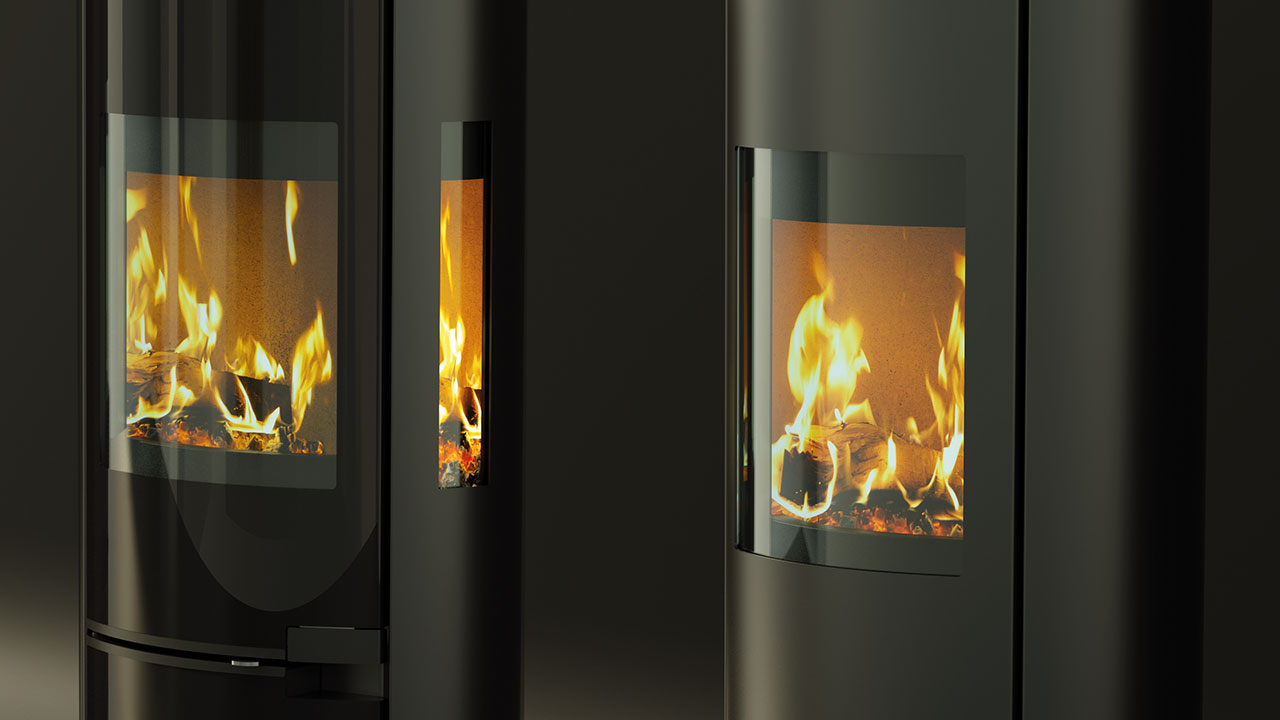
FAQ Frequently Asked Questions
We have a set of Frequently Asked Questions which cover our products, as well as installation and purchase/delivery queries. Please note that this page is in BETA stage, which means it will be updated on a regular basis over the next few weeks.
All our installation guides are available as PDF downloads, so feel free to click here to download. The guides contain far more detail on installation along with important safety advice, as well as guarantee requirements.
Installation Questions
Why do I have to put an vent opening in the wall
An air vent is required for safety reasons, to ensure that there is enough oxygen available for a stove to burn wood efficiently. The stove requires combustion air, but DEFRA approved appliances do not always need external air vents.
Most houses in the UK don’t need any extra ventilation if the stove is rate at 5kW or less. An air vent is needed for anything above this.
How can I reduce downdraft?
Down draft issues can be caused by a number of reasons, such as insufficient height of the flue and also pressure zones.
The first test is to try and raise the chimney out of the pressure zone. This can be done by the means of a temporary flue to test if the procedure has worked, then a permanent flue size increase after this.
How can I eliminate or prevent condensates in flue?
It is important to maintain sufficiently high flue gas temperatures in order to avoid condensate and acid corrosion problems, and to ensure complete combustion of the fuel. The chimney system should be designed to ensure the flue gas temperature are maintained as long as possible
Condensates won’t be entirely removed, but disposal is important, so any ‘horizontal’ runs should allow for a minimum 3° slope and therefore, where required, 87° bends and 93° tees must be used rather than 90° bends and tees to allow the condensate to run off and a tee plug or drain cap used.
In external systems a drain should be fitted to ensure no build up of excess rainwater or slight condensation
How can I increase updraft
Increasing the diameter of the flue will help to increase the draft. In some cases, fans are used, but this isn’t entirely necessary and would be a last resort.
Distance to combustibles?
We have an extensive article about distance to combustibles which has all the information needed – click here.
On that page, you will find information on distance to combustibles for all our range:
What diameter flue do I need for a large fireplace opening
It all depends on the size of the fireplace. The larger the fireplace, the larger the diameter. The flue diameter must be 15% of the cross sectional area of the fireplace opening, then it’s the consideration of the height.
What kind of flue do I use for a boiler?
Each boiler can be different, so it’s best to have a look at the user guide of the boiler to determine the type and the diameter of flue. Our brochure, Choosing the Right Flue for your Appliance can also give you some guidance on the correct flue to use.
Isokern Internal Double Module System Chimney through the house
Do I need to put sealant in the joint between flue pipe and the Isokern stainless steel adaptor?
- No sealant is needed so the pipe can expand and contract when in use
How do I fix the adaptor to the support block?
- The adaptor comes supplied with a fibre tape seal to allow for a simple push fit onto the support block spigot
Do I need to bet the support block?
- Yes it should be bedded onto the lintels with a week mix mortar
Which way up do the outer casings go?
- Socket down and raised rebate uppermost
Which way up do the inner flue blocks go?
- Socket uppermost and rebate down, The half height starter flue block should be fitted first, it is cut flush reading for lip gluing onto the support block
What distance do I need to combustible materials?
- 38mm is required to structural timbers but floorboards, skirting boards can go against the outer casings. Dense rock wool is recommended to pack the gap between floor joists and rafters
How do I finish the outer casings?
- It is best to dry line the casings with plasterboard on dabs but it is also possible to plaster directly to them. Above the roof you can render directly to the outer casings
Can I offset the chimney?
- Yes by using the offset blocks, they can only be used directly above the support block or firechest gather and they must be fully supported
Do I need casing ties?
- Casing ties are only normally needed for external chimneys (2 every 1.5m) internal chimneys normally get their support from the floor and loft boards.
Can I change to a brick chimney above the roof?
- Yes by using a concrete corbel slab in the loft space just below the roof.
Do I still need the outer casings inside the brickwork?
- Only if the chimney is taller than 1.4m above the last point of contact with the roof. Roof timbers can go hard against the brickwork for bracing
Do I need a lead tray and weep holes?
- A full lead tray is required at the roof line for brick stacks, the lead should be dressed up the outside of the flue block by 50mm
- Weep holes are required above the lead tray for water drainage
- If you are rendering the outer casings above the roof then you only require suitable lead flashings. The render must be made waterproof
How do I finish the chimney stack?
- You can use one of our cappings for brickwork or render. You can then finish with our aluminium top ring & rain cap or flaunching around a suitable chimney pot
Magnum Firechest Installation
Do I use lip glue to bed the base slab?
- No, you can bed the base slab on mortar which will help to level it.
How much lip glue do I use?
- Lip glue should be applied using the application bags provided, you should create 20-25mm beads of glue and apply as per the video instructions. The finished joint should be 2-3mm thick.
Do I need to glue the firechest to a back wall?
- No, the firechest can be built against a wall but not glued to it.
How do I fix the damper in place?
- The damper should not be fixed or bedded in place to allow for expansion, its weight will hold it in place.
Can I use the damper to control the fire
- No, The damper is there to close the flue off when not in use to save on heat lose, it must be opened before lighting.
Can I put timber against the firechest?
- The firechest must have 100mm of masonry to each side and behind the back of the firechest. You can finish the front with plasterboard on dabs or render using mesh.
What distance do I need to combustible materials?
- Timber can go against the surrounding 100mm of masonry, 40mm is required from the front face of the gather to timber, A wooden fireplace surround can go against the face of the firechest.
How do I finish the inside of the firechest?
- You will need firebrick slips, these are 50mm thick for the back and base and 25mm thick for the sides.
How do I fix the Firebricks?
- They should be glued on using the Firebrick Mortar and then pointed in, the base bricks should be laid loose, the front row can be glued in.
What combustion air is required?
- We state in our instructions and brochure how much free air is required for combustion for each model.
Can I put the combustion air inside the firechest?
- The free air must be provided to the room via air bricks into the walls, floor or ceiling but cannot be put into the opening.
How to install stove in a conservatory?
With existing conservatories and new ones, the idea of having a wood burning stove is quite a desirable idea. A lot of conservatories tend to be naturally cold due to the number of windows, as well as almost non-existent insulation.
However, when adding a stove, the problematic issue is combustible UPVC parts, as well as combustible ceilings and roofs in general which tend to form a structure of a conservatory.
We have an article here, which goes into more detail on how to install a wood burning stove into a conservatory.
Isokern External Double Module System Chimney with Ignis Protect
Which way up do the outer casings go?
- Socket down and raised rebate uppermost
Which way up do the inner flue blocks go?
- Socket uppermost and rebate down, The half height starter flue block should be fitted first, it is cut flush reading for lip gluing onto the foundation
Where do I use Lip Glue?
- Lip glue is required to glue all the outer casings and the inner flue blocks. The finished joint should be 2-3mm thick, any access glue must be wiped off
Do I need casing ties?
- Casing ties are only normally needed for external chimneys (2 every 1.5m)
Do I need reinforcement rods?
- If you cannot secure the chimney to the wall with suitable ties then you will need rods and if the chimney is more than 1.4m in height above the last point of contact with the roof. The rods should be fitted at least 600mm down into the foundation.
What do I poor around the rods?
- You should poor a grout mix (1:3 cement/sand) around the rods as you go.
How Do I seal the soot door spigot into the access flue block?
- It is supplied with fibre rope seal that wraps around the spigot. No sealant is needed.
What do I do with the flue block void below the soot door?
- It should be filled with a leca mix 10:1 with cement (the mix should be wet)
How Do I seal the flue pipe into the access flue kit?
- You will need fibre rope to wrap around the flue pipe as it enters the casing and flue block. Make sure the flue pipe is cut so it doesn’t block the flue way.
How do I finish the outer casings?
- You can render directly to the outer casings with a suitable waterproof render. The recommended mix is 1:2:5-6 cement:lime:sand for the undercoats and 1:2:8-9 for the final coat.
Do I need a lead tray and weep holes?
- For rendered chimneys you only require suitable lead flashings. The render finish must be made waterproof.
How do I finish the chimney stack?
- You can use one of our cappings for render. You can then finish with our aluminium top ring & rain cap or flaunching around a suitable chimney pot
Purchase and Delivery Questions
How can I return products?
Contact us on 0191 4161150. Items can incur a re-stocking fee.
Can I buy direct?
We have a distribution network, as well as various merchants who retail our products.
Where can I buy products?
Our products are available from various builders merchant and distributors. We have a distributor list on our Product Information Finder, which will allow you to select products, add them to a wish list and print, or email that to your chosen distributors..
How much are carriage costs?
Depends on quantity, as well as date of delivery.
Do you deal direct with Stove Shops or installers?
We don’t deal directly, but have a network of distributors and merchants nearby to you.
Do you deliver direct to site on our behalf?
We can, please contact us for more details.
Do you know where your nearest distributor is in my area?
I you visit our Product Information Finder, you will be able to enter in address details and find the nearest distributor to you.
Which days do you deliver into my area?
We can deliver next day if required.
Product Questions
What is the correct chimney system needed for my Stove?
There are essentially two parts to an effective chimney for a stove:
- The Connecting Flue Pipe, connecting the stove to the chimney system or flexible liner.
- The main chimney system, which can be composed of either a Chimney Liner (Rigid or Flexible) in an existing masonry chimney or a System Chimney (Twin Wall Insulated) for a new building or for retrofit where the building does not have an existing chimney.
Click here to see more detailed information on the correct flue for your stove.
What is the warranty of your products?
For ICID and Flex, it’s a lifetime warranty. We are confident in our products and so offer you a generous guarantee in relation to the ICID and Flex system. Provided that you comply in full with Your Responsibilities
- a period equal to the guarantee period of the appliance to which the Liner is first connected; or
- 20 years.
For example, if your System is fitted to an appliance with a guarantee period of 10 years, we will still guarantee your System for 20 years.
In the unlikely event that the System becomes defective during the guarantee period, we will provide a like-for-like replacement for free (subject to your compliance with Your Responsibilities and subject to the Small Print). If the same model is no longer available, we will replace it with a suitable alternative.
When we say ‘no quibbles’ we mean it and so the guarantee we offer is a straightforward one; we’ve set out below what is covered and what isn’t by the guarantee as well how to ensure you benefit from it.
For our other ranges, under normal operating conditions and providing the system is installed correctly, it should last the lifetime of the appliance which is normally 10 years.
The conditions are that the chimney is:
- Correctly sized and installed
- Properly maintained
- Burning only approved fuels in accordance with the Schiedel Rite-Vent and appliance manufacturer’s instructions.
For recommended fuels listings, please refer to the HETAS guide (www.hetas.co.uk), or appliance manufacturer’s instructions. Warranty registration details are provided with installation instructions for completion and registration with Schiedel Rite Vent.
Do locking bands come with the pipe?
Locking bands are only provided with twin wall systems such as ICS and ICID and also the HP5000 range. To summarise, locking bands are provided with the following ranges
ICID
ICS
ICS5000
HP5000
HP single wall
Locking bands DO NOT come with the following products:
Prima Plus
Prima Smooth (No locking bands required)
B-Vent (No Locking bands required)
How many seals do people need?
In general, only 1 seal per joint is needed.
What is longest flex in 250mm diameter and 300mm diameter?
 The longest flex in 250mm diameter is 12 metres and this can be coiled.
The longest flex in 250mm diameter is 12 metres and this can be coiled.
The longest flex in 300mm diameter is 12 metres, but this cannot be coiled and will be shipped as a straight length.
The lengths can be connected using a Screw fit joiner, which can be available at the larger diameters on request, however it’s not always recommended to have a joint within a flex system unless there is no other option.
I heard that stoves are going to be banned. Is that true?
It certainly isn’t true!
The Clean Air Act is focusing on old stoves and general wood burning (even in your garden). You’ll see on this site the details on Ecodesign Stoves, as well as the correct way to burn wood and other fuels.
This page will take you to some interesting facts and figures and you will see the Ecodesign range, along with proper sweeping and correct fuel means that wood burning is environmentally positive.




